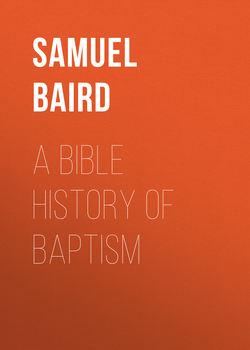Читать книгу A Bible History of Baptism - Baird Samuel John - Страница 30
Book I.
OLD TESTAMENT HISTORY
Part IV.
THE RITUAL SELF-WASHINGS
Section XXVII. —Mode implied in the Meaning of the Rite
ОглавлениеThe instructiveness and utility of types and symbols consist in an appreciable analogy between them and the spiritual things which they are appointed to symbolize. In the case of the Old Testament self-washings, I suppose it has never entered the imagination of any one that they were types of the burial of the Lord Jesus. Of such an interpretation there is not a trace anywhere in the Scriptures. On the contrary, such meaning is there attributed to them that, in order to a sustained analogy, the subject of the rite should, by a voluntary and active exercise of his own powers take and apply the water to his members and person, for their cleansing. In this respect, they stand in emphatic contrast with the sprinkled water of purifying. That was designed to concentrate the attention of Israel upon the active agency of the Mediator, in bestowing the baptism of his blood and Spirit, for the renewing and quickening of dead souls. In it, therefore, the subject was the passive recipient of rites dispensed by the hands of another. But the activity of the Christian life and warfare were symbolized by the self-washings. Christ’s grace is given his people, not to sanction supineness and indolence; but to stimulate to activity in the pursuit of holiness. As the Spirit is now to them an opened fountain, they are to have recourse to it, to seek and obtain, day by day, more grace, for the purging of the flesh, for overcoming the world, for bringing forth the fruits of the Spirit, for fighting the good fight of faith and laying hold on eternal life.
This, which comprehends the whole matter of practical religion is urged in the Scriptures, not only by direct and continual admonitions, but in the use of every variety of figures and illustrations. It was the lesson taught, under the figure of self-washing. Pure water is alike adapted to quicken the soil, to quench the thirst, and to cleanse the garments and the person. But, as the water of life will not quench the thirst of the soul, unless we come and drink, neither will it purge away the defilements of evil, unless we take it and apply it, with diligence and labor. “Wash ye! make you clean; put away the evil of your doings from before mine eyes; cease to do evil; learn to do well; seek judgment, relieve the oppressed, judge the fatherless, plead for the widow.” – Isa. i, 16, 17. The Spirit thus clearly indicates that self-washing signified an intense and life-pervasive activity, – an activity applied, in detail, to each particular relation and duty, so as to purge out every principle of evil, and conform every act to the law of holiness. To correspond with this meaning of the rite, its form should be such as to call forth the active energies of the subject, by the application of the water to the appointed parts and members of the person in detail; and by such successive manipulation as is proper to secure a thorough cleansing. The ordinary mode of washing, among Israel, as we shall presently see, perfectly met these requirements; whilst immersion would have been wholly inadequate, not to say directly contradictory to them, since it indicates a mere passive recipiency, and not an active appropriation and use of the means of cleansing.
